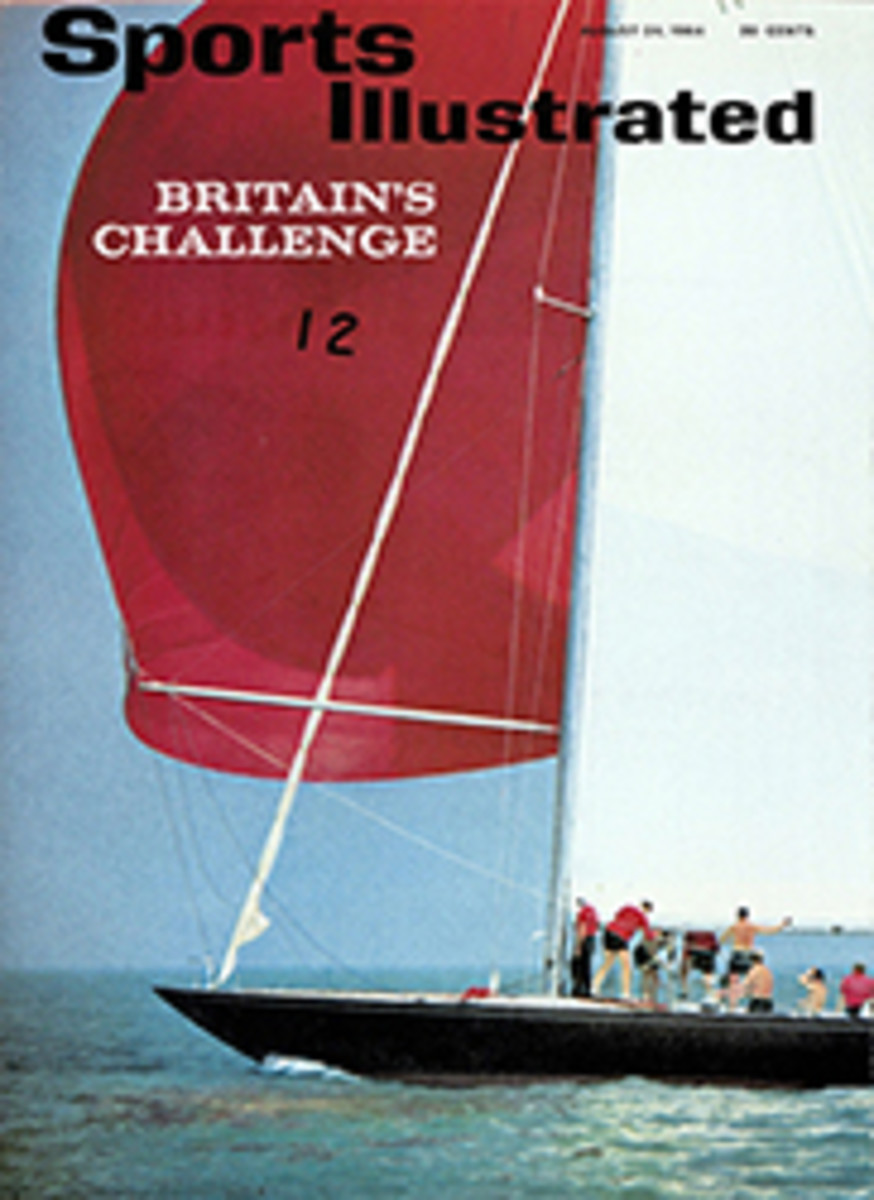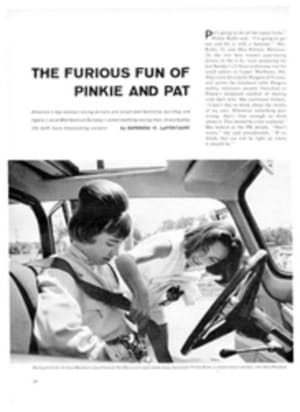
THE FURIOUS FUN OF PINKIE AND PAT
Pat's going to do all the repair work," Pinkie Rollo said. "I'm going to get out and hit it with a hammer." Mrs. Rollo, 32, and Miss Patricia Mernone, 24, the two best women auto-racing drivers in the U.S., were preparing for last Sunday's 12-hour endurance run for small sedans at Upper Marlboro, Md. They were driving for Peugeot of France, and across the luncheon table Peugeot public relations people blanched at Pinkie's proposed method of dealing with their bébé. She continued blithely, "I don't like to think about the insides of my cars. Whenever something goes wrong, that's time enough to think about it. This should be a fun weekend." She looked at the PR people. "Don't worry," she said considerately. "If we finish, that car will be right up where it should be."
They finished, and well—fifth in their class and 10th overall, ahead of 17 teams of men drivers. What Pinkie said when a wheel cracked late in the race, costing 13 minutes for a replacement, was not recorded, and it is probably just as well that the wheel manufacturer was not around to hear. After that the brakes failed, and only Pinkie's skill kept the car on the course for the final hour.
Neither Pinkie nor Pat looks like a racing driver, if it may be said that there is any one way racing drivers look (husky? tough? leathery?). Both are small and feminine. Pinkie is a respectable five and a half feet tall but weighs only 113 pounds, and Pat, at 5 feet 2, weighs 100 on a fat day. Pinkie has driven sports cars competitively for nine years—Jaguars, MGs, Corvettes, Alfa Romeos and, at present, a Triumph Spitfire. She has been first in a Marlboro six-hour race and has only recently slipped from third to fourth in the national point standings for small racers like the Spitfire. Pat has had her foot on a racing throttle only since 1961 and has performed the remarkable feat of winning 70% of her races, all of them over men. She has been first, second or third 90% of the time and in her Morgan 4/4 is second in the Sports Car Club of America's Northeast divisional series.
"The two of them are taken seriously by their real competition," says their manager, Ed Grant. "It's only among the tag end of the pack that you run into any problem. Those guys are out there to wave at their girl friends, and I don't know what they say to them afterward when they've been bombed by a little 100-pound girl."
The little 100-pound girl lives at home in Washington with her parents, where she plays with her dog Tammy, makes most of her own clothes and drinks enormous quantities of Coca-Cola. For all of these gentle pursuits, Patricia is a tigress. She is serious about her racing, which she pursues with an almost adolescent fervor. "Pat always used to be concerned about the moment when she would be stuffing metal into metal," says Grant, perhaps a trifle luridly, "but when a guy in an Abarth coupe really leaned on her, she didn't give."
Driving in Washington traffic with Patricia is not for the feeble-hearted. "You have to treat driving in traffic as a game, or a challenge," she explained the other day, immediately putting her philosophy into practice in a Sunbeam which she calls Eustace. "Otherwise you won't get anywhere in the rush hour. Come on, stupid! This car is stupid." She brightened. "Watch this!" Zoom, across the tail of a stout, middle-aged Ford went Eustace. "Oh, my father is right," she said. "One of these days I'm going to get thrown into jail. My father took me to see my first sports car race at Marlboro. That was in May of 1961, and in September the two of us were in race-driving school. My father thought it would improve his rally driving." Pat decided to give up rallying for racing, on the interesting ground that racing is safer. "In rallying you get lost and have to do wild things at night to catch up."
Pat got something real to race when an aunt came to visit—an aunt on the paternal, or competitive, side of the family. She watched Pat race a tiny Austin-Healey Sprite, and afterward materialized in the pits, asking her what she wanted for Christmas. Pat and her mechanic huddled and decided that she wanted a Morgan. Pat's aunt gave her the Morgan, but she supports it herself—as an organic microanalytical chemist. All in all, Pat Mernone is not frivolous.
Frivolous is precisely the word applied to Pinkie, by people who do not know her well, because of her waggish tongue. As she puts it, "I'm not one of those Briggs Cunningham types, up at 6 doing calisthenics." A freckle-faced redhead born Marianne Wheatley, Pinkie trained and showed horses from the time she was 6 until her first husband's interest in sports car racing rubbed off on her. Her present husband, Reed Rollo, also drives, or did until he wrecked his last car. "That's the guard rail where he smashed the Cooper," Pinkie said at Marlboro. "This is the rail I hit. We're going to paint them 'His' and 'Hers.' "
Pinkie got her second marriage off to what might have seemed an inauspicious start when, at Marlboro in 1962, she crashed and damaged two things dear to her husband: her own face and his Alfa Romeo Veloce. "He's wonderful about it," Pinkie says. "No matter how bad a fight gets, Reed never says, 'You smashed up my car.'
"I was passing this guy, and I don't think he liked to be passed by a girl, though we've had drinks with him since, and he denies it. But he got into a fit or something and put his foot on the floor. He ran into the guard rail. I thought he was going over; I could see the whole bottom of his car. But he didn't. He came back down and hit my right rear fender. It disintegrated his car. He wasn't hurt, but then our car went into the guard rail. I had a terrible concussion. My nose was fragmented. The break went so far up it was almost a skull fracture—and my forehead was one gigantic hematoma and my upper lip was gone. It was cut down and across, and just hanging. It hurt. Then I went through this phase when I just said, 'Get me a veil. Draw the blinds. Everybody sit over there.' Camille."
Today Pinkie is cheerful. No sign of the accident is left except a small curved scar above her upper lip, and that can be sanded away when she has the time. "I look the same," she says, "if you don't really look. But it disturbs me. Let's face it, you're used to looking the way you look, and you're not very interested in looking like somebody else, even if it's Elizabeth Taylor. What it really is, my nose is more turned up. They do these things under a local anesthetic, and I could hear the surgeon saying to the nurses, 'How does that look?' and they'd say, 'Oh, I don't know.' 'You've got an awfully pug nose,' he told me. 'How would you like it a little classical?' I just said, 'Do something.' "
Pinkie is Placement Officer for Goodwill Industries in the District of Columbia, where she has complete responsibility for all placement of rehabilitated persons in the Washington area. She has been at it since November, but not as a consequence of her own accident. "It wasn't conscious at all, though I do find I relate well to some kinds of handicapped people," she says. "I worked in a personnel agency before and found myself working with the handicapped people, and in November I got into placement work with Goodwill."
It is a tough job, and the evidence is that Pinkie is first-rate. "You have to take them out by the hand and say, 'Here he is. I know he's got a criminal record for assaulting little children, but you're going to love him.' We're trying to change our image here at Goodwill from a lot of little Methodists to more of a Peace Corps type of group."
As for the image of Pinkie and Pat at the racecourses—two sprightly women who will give anyone a scrap—no change is contemplated.
PHOTO
During trials for 12-hour Marlboro race Chemist Pat Mernone (right) helps strap teammate Pinkie Rollo, a rehabilitation worker, into their Peugeot.

